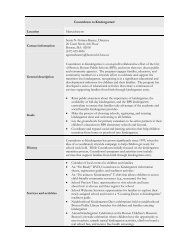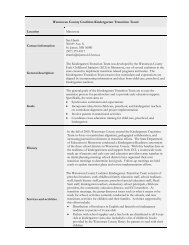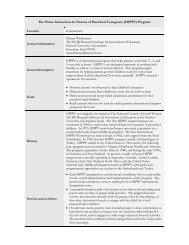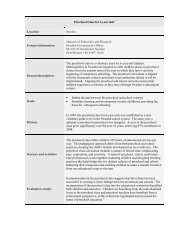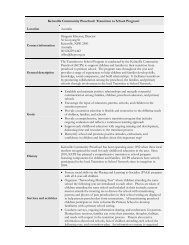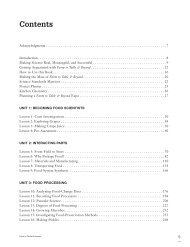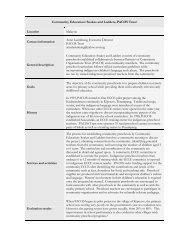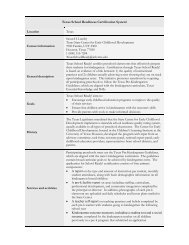Proceedings of the Fourth Annual Teachers College Educational ...
Proceedings of the Fourth Annual Teachers College Educational ...
Proceedings of the Fourth Annual Teachers College Educational ...
You also want an ePaper? Increase the reach of your titles
YUMPU automatically turns print PDFs into web optimized ePapers that Google loves.
Connected to Word Problems:<br />
Improving Ma<strong>the</strong>matical Problem Solving While Exergaming<br />
Benjamin Friedman,<br />
<strong>Teachers</strong> <strong>College</strong>, Columbia University, New York, NY,<br />
Email: bpf2103@tc.columbia.edu<br />
Abstract: How can we best prepare students for instruction and practice in solving<br />
ma<strong>the</strong>matical word problems? What instructional methods best promote understanding <strong>of</strong><br />
problem situations and sense making in students? These are important questions given<br />
<strong>the</strong> prominent place making sense <strong>of</strong> problems and working to solve <strong>the</strong>m has in <strong>the</strong><br />
Common Core State Standards for Ma<strong>the</strong>matical Practice (2010).<br />
This quasi-experimental study seeks to answer <strong>the</strong>se questions by comparing an<br />
instructionally embodied teaching method (Black, Segal, Vitale, & Fadjo, 2011) with a<br />
conceptual model based method (Xin, Wiles, & Lin, 2008; Xin & Zhang, 2009) as well as<br />
a mix between <strong>the</strong> two methods. Twelve second-grade students from a high-needs urban<br />
public school participated through an after-school program. All students participated in<br />
fitness game activities through <strong>the</strong> Xbox Kinect. Word problem situations were based <strong>of</strong>f<br />
those students experienced in <strong>the</strong> fitness game for instructionally embodied conditions<br />
but not for <strong>the</strong> conceptual model condition.<br />
Relevant Literature<br />
Word problems are <strong>the</strong> most common problem type encountered by students at all levels <strong>of</strong> education<br />
(Jonassen, 2003). Many students in <strong>the</strong> early grades have difficulty solving ma<strong>the</strong>matical word problems,<br />
especially English Language Learners (ELLs) and those with learning disabilities (Jitendra, 2008). In <strong>the</strong><br />
context <strong>of</strong> this study word problems are defined as problems taken from situations in <strong>the</strong> real-world that<br />
require <strong>the</strong> use <strong>of</strong> ma<strong>the</strong>matical concepts in order to obtain a solution (Verschaffel, Greer, & De Corte,<br />
2000). These types <strong>of</strong> problems provide an important connection between situations expressed through<br />
language and <strong>the</strong> abstract ma<strong>the</strong>matical language that is expressed in numbers and symbols. Solving<br />
ma<strong>the</strong>matical word problems involves both reading comprehension and ma<strong>the</strong>matical skills such as<br />
conceptual understanding <strong>of</strong> operations and computational ability (Kintsch & Greeno, 1985).<br />
One reason for a lack <strong>of</strong> student success in solving ma<strong>the</strong>matical word problems is <strong>the</strong> suspension <strong>of</strong><br />
sense making that occurs when students focus on obtaining an answer without first attempting to make<br />
sense <strong>of</strong> <strong>the</strong> problem. Consequently, students may ignore clues that explain what information needs to be<br />
used and what procedures are necessary to find <strong>the</strong> correct solution (Verschaffel, Greer, & De Corte<br />
2000). Sense making ability may improve through instruction that engages students in using problem<br />
solving skills and provides opportunities for <strong>the</strong>m to reason about <strong>the</strong> information contained in <strong>the</strong><br />
problem as well as <strong>the</strong> information that is missing.<br />
Types <strong>of</strong> Instruction<br />
This study attempted to engage students in sense making by comparing instructional methods, namely,<br />
an instructionally embodied approach (Black, Segal, Vitale, & Fadjo, 2011), a conceptual model based<br />
approach (Xin, Wiles, & Lin, 2008; Xin & Zhang, 2009), and a mix between <strong>the</strong> two methods. Twelve<br />
second-grade students from a high-needs urban public school participated in <strong>the</strong> study through an afterschool<br />
program in one <strong>of</strong> <strong>the</strong> three groups. All groups took part in exergame activities (described below)<br />
through <strong>the</strong> Xbox Kinect gaming system.<br />
For students in <strong>the</strong> instructionally embodied and mixed groups, <strong>the</strong>se exergame activities became <strong>the</strong><br />
basis for experimenter written problems used during instruction (see Table 1). This was meant to ground<br />
<strong>the</strong>ir internal representations <strong>of</strong> problem situations in physical and perceptual experiences (Barsalou,<br />
2010). Students were <strong>the</strong>n taught to visualize <strong>the</strong>ir exergame activities in order to mentally manipulate<br />
problem elements, resulting in improved ability to solve problems independently. Conceptual model<br />
based instruction consisted <strong>of</strong> teaching specific word problem story grammars that led students to identify<br />
ma<strong>the</strong>matical structural relations for specific problem types. This knowledge <strong>the</strong>n allowed <strong>the</strong>m to<br />
18



